This post may contain affiliate links. Please read our disclosure policy.
Soft and fluffy Japanese-style milk bread infused with pumpkin puree. The smell of the bread while baking is out of this world! The bread is made with sourdough sweet stiff starter.

This is not a pumpkin quick bread that is made without yeast and has a texture more like a cross between cake and bread, moist and dense which is quite popular here in the U.S. What I”m sharing here is pumpkin bread leavened with natural yeast (sourdough). The bread has a soft and fluffy texture like sandwich bread loaf.
I love making bread with pumpkin or potatoes because they always yield very soft bread. If you love baking with pumpkin, you must try this pumpkin shokupan recipe. A while ago I also made pumpkin shokupan using poolish and poolish also yields really good soft bread. If you don’t have a sourdough starter, definitely check out that post!
No Sour Sourdough Bread
This recipe will give you sourdough bread that doesn’t taste sour. Why? Because we use a Sweet Stiff Levain, which is built from a regular 100% hydration sourdough starter. I don’t maintain a stiff starter. I build it whenever I need it. I love baking enriched bread/buns and steamed buns using a sweet stiff starter.
How to make sourdough pumpkin shokupan using sweet stiff starter
1. I use canned pumpkin puree (not pumpkin pie mix). If you use fresh pumpkin, cut into large chunks. Steam over high heat for 15-20 minutes or until fork-tender. Mash until smooth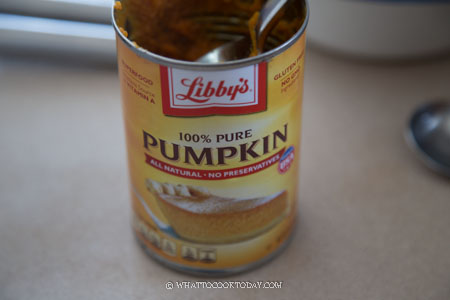
2. About 8-10 hours before you plan to make the bread, combine all ingredients for the stiff starter in a bowl. Stir a bit to roughly combine and then use your clean hand to knead it. This is a stiff starter, it’s like a dough. Make sure no pockets of dry flour are visible. Transfer to a large see-through container (plastic or glass is fine, preferably wide-mouth so you can get it out easier later). Loosely cover with the lid and let it ferment until triple in size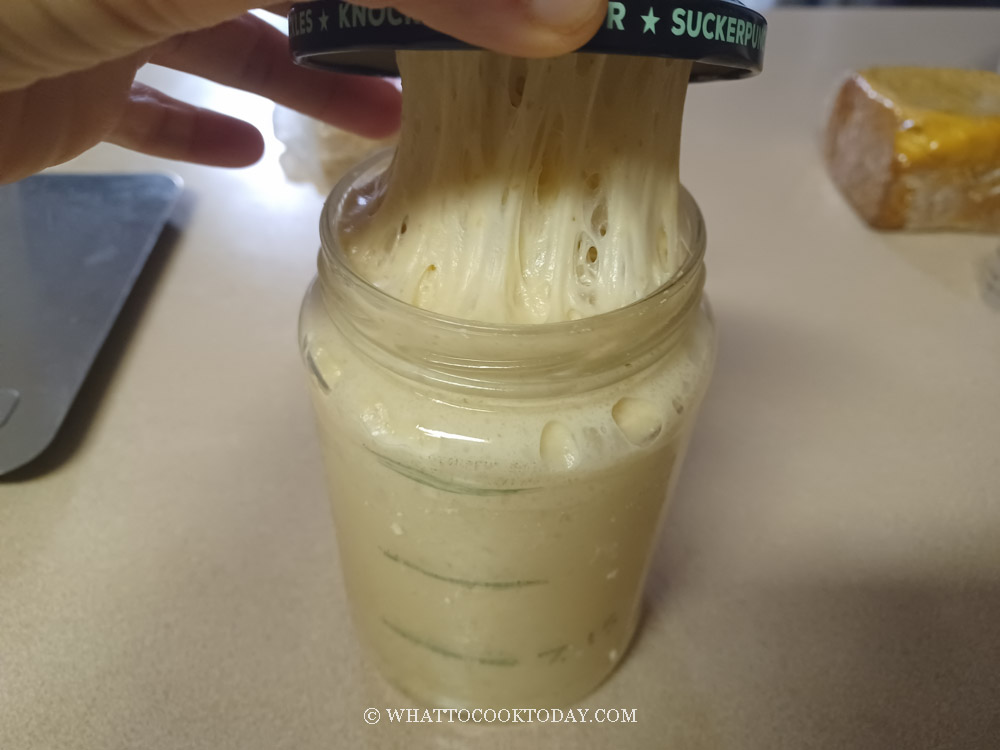
3. Place all ingredients (except for butter), including all of the sweet stiff starter, in a mixing bowl of a stand mixer fitted with a dough hook attachment. Use the hook to stir everything around a bit so when you turn the machine on, the flour won’t fly around and wet ingredients won’t splash (it happened to me before!).
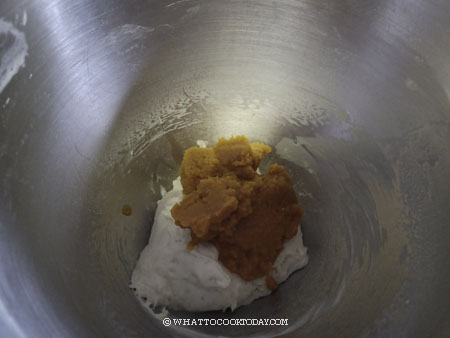
4. Start with the lowest speed to mix things up and then increase to speed 2 and knead for about 5 minutes or until it forms a dough. If the dough is too dry to come together, you can add a bit of milk one teaspoon at a time. Don’t add too much as we haven’t added the butter yet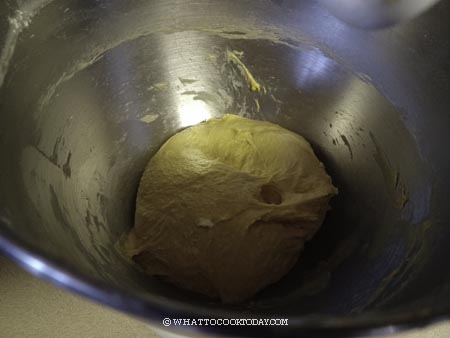
5. Then add butter, in 2-3 batches. The dough will turn into a complete mess again because of the butter, but don’t worry, it will get absorbed by the dough as it kneads. Knead at speed 4 for about 10 minutes or until the dough is smooth and elastic. If you slowly stretch a small amount of dough, it will not break and light can pass through, like a window pane. Proceed to first proofing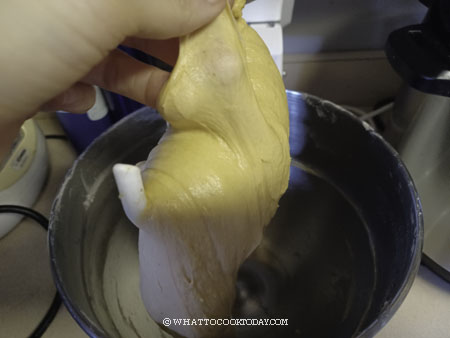
6. Transfer to a lightly oiled bowl, cover, and proof at a warm place for 2 hours, about 78-82 F (26-28 C), the dough may not double in size, but that’s okay. It should rise to about 1.5 x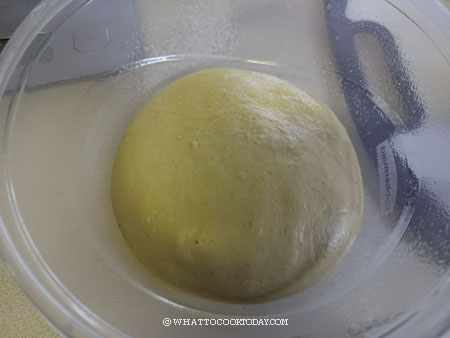
7. Please refer to the recipe card if you plan to bake the next day. You can cold retard the dough in the fridge. Lightly grease your loaf pan on all sides. Punch the dough down and give it a knead for a few times. Divide into 3 equal -size smaller doughs. Round up each dough to roughly form a ball. Cover and let them rest for 15 minutes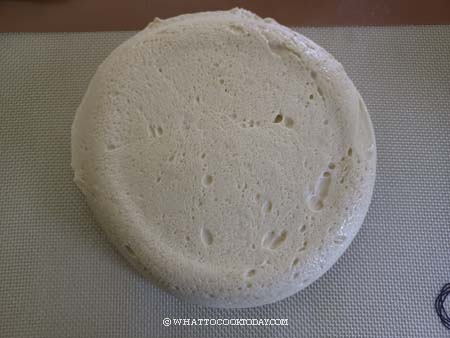
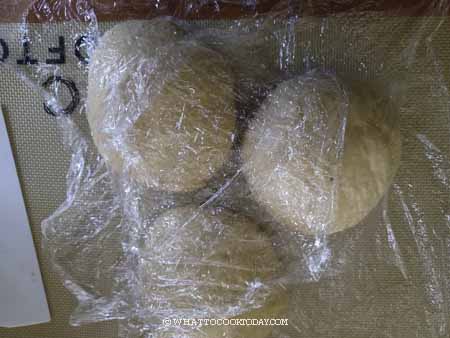
8. Then work with one dough at a time and keep the rest covered. Flatten the dough with your palm and roll it into a rectangle shape, the width should about twice the width of the loaf pan and about the same length as the loaf pan. Fold the two sides over to meet in the middle and then roll the dough up, not too tight, not too loose, like a Swiss roll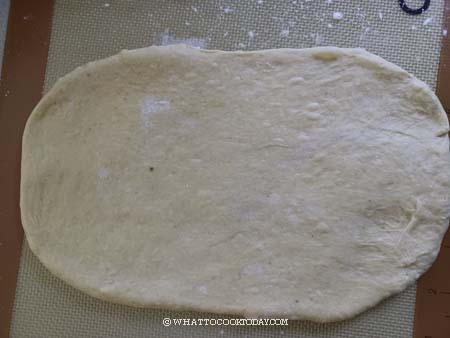
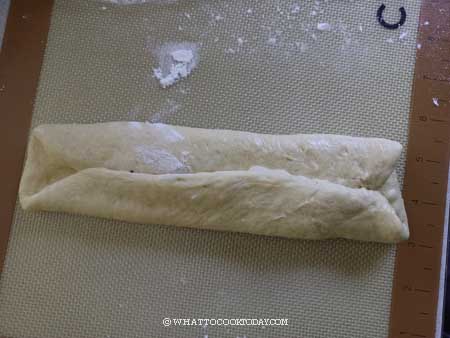
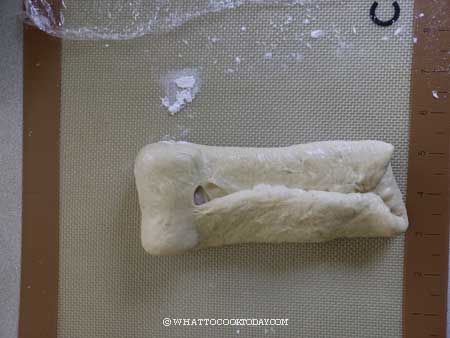
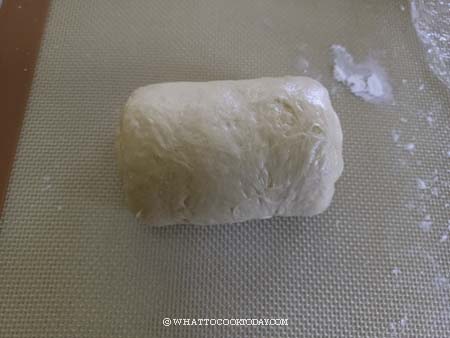
9. Place the shaped dough into the pan. Repeat with the other two doughs. Place all the shaped dough side by side inside the loaf pan. Slightly flatten the three doughs with your palm so they are about the same height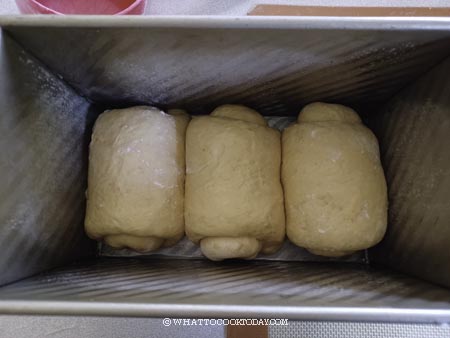
10. Cover and let the dough proof again at a warm place until it fills up about 90% of the pan. This may take about 3-4 hours at 82 F. 10 minutes before the end of proofing, preheat your oven to 350 F (180 C) for a conventional bottom-heat only oven. For convection top and bottom heat, lower the temperature by 20 F or 15 C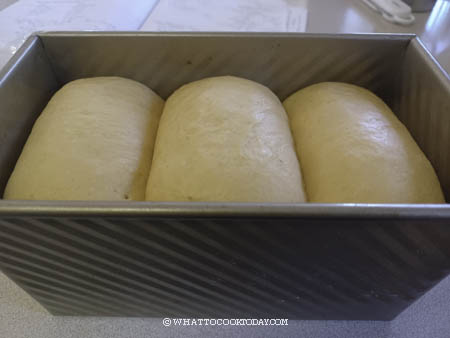
11. Whisk the egg with milk for an egg wash. Brush the surface with an egg wash. 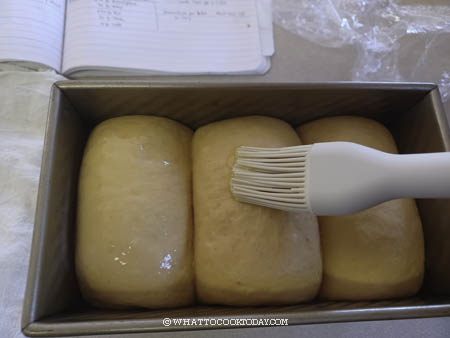
12. This is optional, you can use a scissor to cut the surface to create some scoring (as shown in the photo). Sprinkle with some sesame seeds or other seeds of your choice or leave it blank if you prefer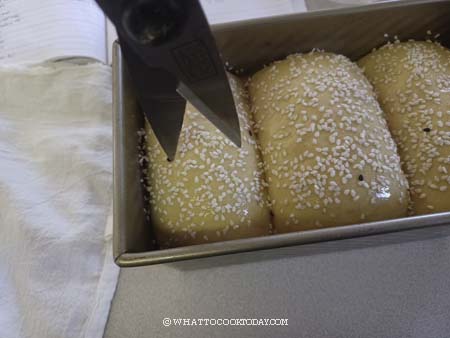
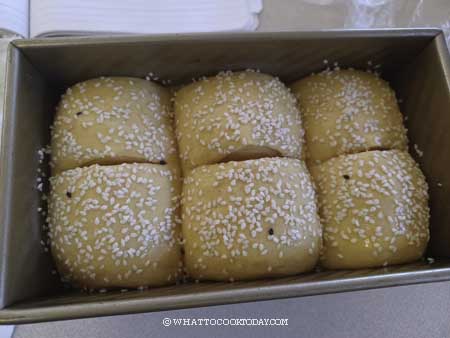
13. Place the loaf pan on the middle rack and bake for 35-40 minutes or until the top is golden brown. Rotate the pan halfway through baking. If the top gets browned too quickly, tent it loosely with aluminum foil, shiny-side facing up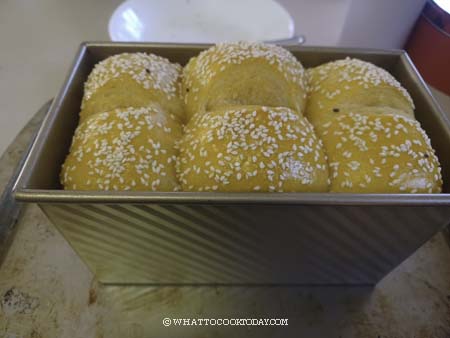
14. Once out of the oven, drop the pan on the counter to release some steam and immediately remove from the pan onto a cooling rack. Optional: If you want a softer shinier crust, you can brush with melted butter immediately while the bread is still warm. Let the bread cools down completely on the rack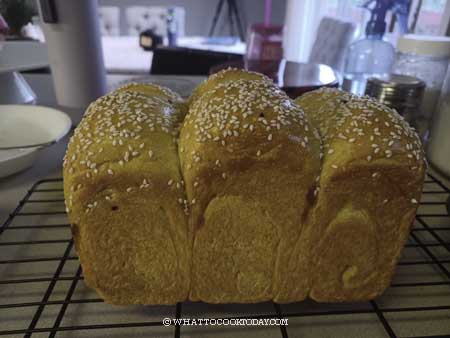
15. Once it has cooled down, you can put in an air-tight container and can be kept at room temperature for 2-3 days and stays soft if properly wrapped to preserve freshness

Did you make this sourdough pumpkin shokupan with sweet stiff starter recipe?
I love it when you guys snap a photo and tag it to show me what you’ve made 🙂 Simply tag me @WhatToCookToday #WhatToCookToday on Instagram and I’ll be sure to stop by and take a peek for real!
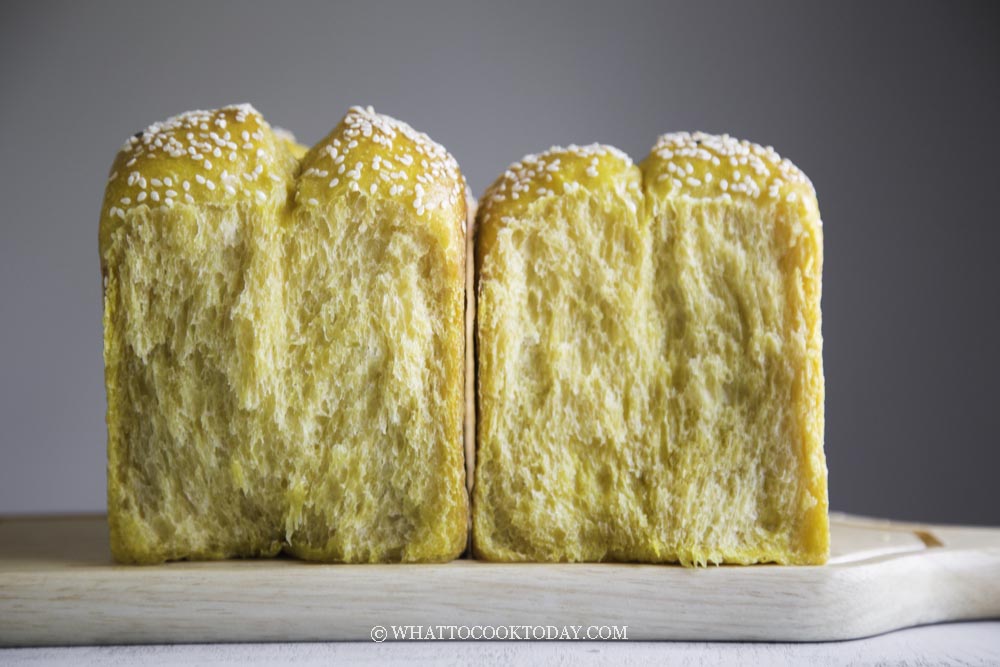
Sourdough Pumpkin Shokupan (Milk Bread)
Ingredients
Sweet stiff starter:
- 30 gr active starter (100% hydration)
- 90 gr bread flour (12.7% protein content)
- 40 gr water
- 30 gr sugar
Dough:
- 210 gr bread flour (12.7% protein content)
- 30 gr sugar
- 4 gr salt
- 85 gr milk
- 125 gr pumpkin puree
- 20 gr softened butter unsalted
Egg wash:
- 1 large egg
- 1 tsp milk
Instructions
- I use canned pumpkin puree (not pumpkin pie mix). If you use fresh pumpkin, cut into large chunks. Steam over high heat for 15-20 minutes or until fork-tender. Mash until smooth
Prepare sweet stiff starter:
- This recipe will give you sourdough bread that doesn't taste sour. Why? Because we use a Sweet Stiff Levain, which is built from regular 100% hydration sourdough starter. I don't maintain stiff starter. I build it whenever I need it. I love baking enriched bread/buns and steamed buns using sweet stiff starter.
- I recommend using a starter that is at least two months old and consistently doubles or triples in 4-6 hours when you feed it at 1:1:1 ratio. Young starter will not give the best result
- About 8-10 hours before you plan to make the bread, combine all ingredients for the stiff starter in a bowl. Stir a bit to roughly combine and then use your clean hand to knead it. This is a stiff starter, it's like a dough. Make sure no pockets of dry flour are visible. Transfer to a large see-through container (plastic or glass is fine, preferably wide-mouth so you can get it out easier later). Loosely cover with the lid and let it ferment until triple in size
Prepare the dough:
- Place all ingredients and stiff starter,except for the butter, in a mixing bowl of a stand mixer fitted with a dough hook attachment. Use the hook to stir everything around a bit so when you turn the machine on, the flour won't fly around and wet ingredients won't splash (it happened to me before!).
- Start with the lowest speed to mix things up and then increase to speed 2 and knead for about 5 minutes or until it forms a dough. If the dough is too dry to come together, you can add a bit of milk one teaspoon at a time. Don't add too much as we haven't added the butter yet
- Then add butter in 2-3 batches. The dough will turn into a complete mess again because of the butter, but don't worry, it will get absorbed by the dough as it kneads. Knead at speed 4 for about 10 minutes or until the dough is smooth and elastic. If you slowly stretch a small amount of dough, it will not break and light can pass through, like a window pane. Proceed to first proofing
First proofing:
- Transfer to a lightly oiled bowl, cover, and proof at a warm place for 2 hours, about 78-82 F (26-28 C), the dough may not double in size, but that's okay. It should rise to about 1.5 x
If you want to bake on the same day:
- Proceed to shaping
If you want to bake the next day:
- If you want to bake the next day, cover the dough tightly and put it in the coldest part of your fridge to let it retard until you are ready to bake for the next day. This will give the loaf a mild hint of tanginess (depending on your starter). The next day, just remove from the fridge and let it sit on the counter for about 30 minutes and then proceed to shaping. If the dough is too stiff from the cold, rest it a bit longer
Shaping:
- Lightly grease your loaf pan on all sides
- Punch the dough down and give it a knead for a few times. Divide into 3 equal -size smaller doughs. Round up each dough to roughly form a ball. Cover and let them rest for 15 minutes
- Then work with one dough at a time and keep the rest covered. Flatten the dough with your palm and roll it into a rectangle shape, the width should about twice the width of the loaf pan and about the same length as the loaf pan. Fold the two sides over to meet in the middle and then roll the dough up, not too tight, not too loose, like a Swiss roll
- Place the shaped dough into the pan. Repeat with the other two doughs. Place all the shaped dough side by side inside the loaf pan. Slightly flatten the three doughs with your palm so they are about the same height
Final proofing:
- Cover and let the dough proof again at a warm place until it fills up about 90% of the pan. This may take about 3-4 hours at 82 F. Final proofing will be longer if your dough is still cold from the fridge if you retard it in the fridge.
Baking:
- 10 minutes before the end of proofing, preheat your oven to 350 F (180 C) for a conventional bottom-heat only oven. For convection top and bottom heat, lower the temperature by 20 F or 15 C
- Whisk the egg with milk for an egg wash. Brush the surface with an egg wash. This is optional, you can use a scissor to cut the surface to create some scoring (as shown in the photo). Sprinkle with some sesame seeds or other seeds of your choice or leave it blank if you prefer
- Place the loaf pan on the middle rack and bake for 35-40 minutes or until the top is golden brown. Rotate the pan halfway through baking. If the top gets browned too quickly, tent it loosely with an aluminum foil, shiny-side facing up
Cooling:
- Once out of the oven, drop the pan on the counter to release some steam and immediately remove from the pan onto a cooling rack. Optional: If you want a softer shinier crust, you can brush with melted butter immediately while the bread is still warm. Let the bread cools down completely on the rack
Storing:
- Once it has cooled down, you can put in an air-tight container and can be kept at room temperature for 2-3 days. The bread should stay soft for few days if kept properly at room temperature


